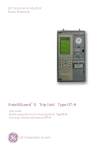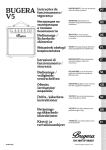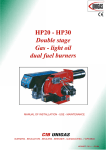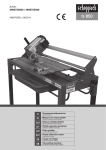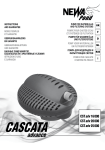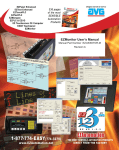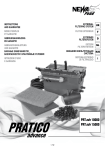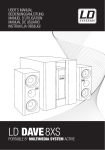Download Instrukcja i charakterystyka pracy DRP
Transcript
DRP DRY-RUNNING PROTECTOR Zabezpieczenie przed suchobiegiem Installation - Operating Instructions Safety - Declaration of Conformity Instrukcja montażu i obsługi Deklaracja zgodności DRP DRY-RUNNING PROTECTOR Zabezpieczenie przed suchobiegiem Installation and operating instructions - Safety - Declaration of conformity 3 GB ZDS reserves the right to make modifications without prior notice. 9 PL Instrukcja montażu i obsługi - Deklaracja zgodności ZDS zastrzega sobie prawo do zmian bez uprzedniego powiadomienia. 2 WIRING DIAGRAM 6 6 8 6 8 8 8 8 10 11 12 5 7 GB 4 5 3 2 3 4 5 D F I E PL 9 9 9 HR MNE 1 1 RO 1 1 – MOTOR CABLE 2 – BLACK (COMMON) 3 – LIGHT BLUE or GREY (RUNNING) 4 – BROWN (START) 5 – YELLOW/GREEN (HEARTHING) 6 – POWER SUPPLY LINE 7 – CAPACITOR 8 – FUSES 9 – DRP 10 – BLACK FASE R, 11 – LIGHT BLUE or GREY FASE S, 12 – BROWN FASE T SRB 6 5 2 3 1 4 Fig. 1 3 Fig. 2 1- Installation and Working Instructions Before installation and operation read the instructions carefully. The fitter and the end user have to respect valid norms and laws, as well as local regulations. This product is in line with valid EU legislation and ZDS declines any responsibility in case of damage caused by improper use or in conditions other than indicated on the type plate or in the usage instructions. 2- Storage and Transport This product should be stored in its original package at temperatures between -15°C and + 50°C. GB D 3- Device Usage The Pump Protector - DRP is an innovative electronic device that guarantees optimal protection of the submerged pump from dry running, overload, high voltage, low voltage, too frequent starts/stops, phase imbalance, phase loss (3-phase). F I The different models available are: E DRP Version 2.0 - BLUE: Single-phase 220-240V ZDS motors “2-wire” (up to 1,5 kW); single-phase ZDS PL DRP Version 3.0 - BLUE: Single-phase 220-240V ZDS motors “3-wire PSC” (2,2kW) and Single-phase HR motors “3-wire PSC” (up to 1,5kW); single-phase Franklin PSC motors (up to 1,5 kW). Franklin PSC motors (2,2 kW). DRP Version 3.0 - RED: Three-phase 380-415V ZDS & Franklin motors (up to 4 kW) and three-phase 220-240V Franklin motors up to 2,2kW. NB! None of the DRPs can be used with a frequency inverter. MNE RO SRB Please be aware that the single-phase 2,2 kW (Version 3.0 – Blue) and all three-phase DRPs (version 3.0 – Red) must ONLY be used with the appropriate motor. The DRPs are adjusted at the factory and must not be exchanged later with another motor (even if it is the same kW). Unless you have been certified by ZDS Srl. and installed proper testing equipment, the warranty is void if the DRP has been used with another motor than the one supplied with the DRP from the factory. The serial numbers of both motors and DRPs are kept at the factory and recorded at the time of despatch. The DRP units are fitted to a short length of cable attached to the motor so that when the pump is installed in the borehole, well or tank, the DRP is located just above the pump-section. For all O2 motors and O3 motors to 1,1kW the cable from the connector of the motor to the sensor is 115cm. For 1,5kW O3 motors the cable length from the connector of the motor to the sensor is 150cm and for 2,2kW O3 motors the cable from the connector of the motor until the sensor is 180 cm. For OT motors the different lengths are: 0,37kw the length is 0.7mt, 0,55kw length is 0.8mt, 0,75kw length is 0.95mt , 1,1kw length is 1.2mt, 1,5kw length is 1.48mt, 2,2kw the length is 1.75mt , 3kw length is 2.17mt and for 4kw the length is 2.17mt. The normal cable to supply the pump is connected to the DRP connection; this means that no extra cable is required, unlike traditional probes. Insulation test with DRP (can it be “meggered”?) The DRP can be meggered up to 500V, please connect the terminal of the megger instrument (negative) to the earth, the other to the black cable, then repeat the same operation with the grey cable and last with the brown cable. The negative cable of the DRP must always be connected to the earth. Dry Running Protection (All Versions) For correct operation both the complete motor and DRP must be completely submerged in the water. When testing the DRP please be aware that the motor and DRP must be put in the same tank of water. Whilst the water covers the sensor, the motor will function normally. However, when the sensor ceases to be in contact with water, the DRP immediately will stop Dry-running 4 the motor. The DRP then attempts to re-start the motor after a period of 30 seconds, automatically, without manual intervention. This automatic reset is programmed with successive attempts of 300s, 600s, 1200s (approx 20 minutes), 2400 seconds and 4800 seconds. If the water comes back and the motor works continuously for a minimum of 30s, the programmed time delay will reset itself automatically. After the last attempt, the DRP will put the pump to ”sleep” and it can only be reset by disconnecting the power supply, i.e. pulling the motor cable from its socket. If this occurs frequently, it simply means that the delivery of the borehole is lower than the delivery of the pump installed and the pump should be replaced with one of lower delivery. Alternatively, you can “throttle back” the delivery by using a valve. GB D F I E PL HR MNE RO SRB Too frequent Starts/Stops – Pressure Vessel Breakdown (All Versions) The DRP will also protect the motor if it is starting and stopping too frequently. This would most likely happen for example if the tank membrane were burst or if the pressure-tank was low in air. This should normally alert the user by virtue of the fact that (s)he would notice that their water supply was intermittent. Too Frequent If the time between the start and stop is lower than 2 seconds, the system will stop for 2 Starts/Stops seconds, then it will try to start again. If the time between the next start and stop is again lower than 2 seconds, the motor will stop for 6 seconds, then it will start again. If the time between the next start and stop is again lower than 2 seconds the motor will stop for 20 seconds, then it will start again. If the time between the next start and stop is again lower than 2 seconds, the motor will stop for 40 seconds, then it will start again. If the time between the next start and stop is again lower than 2 seconds, the motor will stop for 80 seconds, then it will start again. If the time between the next start and stop is again lower than 2 seconds, the motor will stop for 160 seconds, then it will start again. After the last attempt, the DRP will put the pump to ”sleep”. It can only be reset by disconnecting the power-supply, i.e. pulling the motor cable from its socket for a minimum of 10 seconds. If the time between the start and stop is more than 5 seconds, the DRP will be reset automatically. Overload Protection (Version 2.0 – Blue) There is no overload protection built into this DRP Overload Protection (Version 3.0 – Blue & Red) If the current remains below 110% of the max current of the motor, the motor will work continuously. If the current remains 110-125% of the max allowed current for the motor, the DRP will only allow the motor to work for 3000seconds (50 min). After this period of time, the DRP will stop the motor for 15min to protect it from being damaged. If the anomaly continues it will repeat this procedure 20 times before the DRP eventually will put the pump to ”sleep”. It can only be reset by disconnecting the power-supply, i.e. pulling the motor cable from its socket for a minimum of 10 seconds. Overload If the current exceeds 125% of the max allowed current for the motor, the DRP will only allow the motor to work for 1 second. The DRP will stop the motor for 60min to protect it from being damaged. If the anomaly continues it will repeat this procedure 10 times before the DRP eventually will put the pump to ”sleep”. It can only be reset by disconnecting the power-supply, i.e. pulling the motor cable from its socket for a minimum of 10 seconds. If the number of attempts does not reach the “sleep” mode the DRP will automatically be reset after the motor has worked continuously for 5 seconds with a current less than ≤ 110% of max. current of the motor. Protection against peaks of Low & High Voltage (Version 2.0 & 3.0 – Blue/Red) The DRP protects the motor against very short peaks (microseconds) of high voltage up to 1000V. If the voltage remains and exceeds 300V (500V for DRP 3.0 – Red 380-415V) for a High Voltage period of time, it will burn the DRP and must be changed. This may happen if you are trying to run the pump on an undersized generator. We recommend that you use a generator, which has an output of 3 times the minimum requirement for the motor. In other words, a 3kW motor, should at a minimum run on a 9kW generator. 5 As for low voltage the DRP stops the motor after 0.5-1 second if the supply voltage is < 15-20% Vn. The restart occurs automatically when the voltage reaches at least 10-15% of supply voltage Phase imbalance protection (Version 3.0 – Red) The motor will stop only in case of imbalance to live. The restart occurs automatically when the voltage reaches at least 10-15% of supply voltage Example 1: With the following voltages: R-phase 400V S-phase 330V T phase 400V The DRP stops the motor after 0.5-1 second Phase imbalance GB D Example 2: With the following voltages: R-phase 430V S-phase 350V T phase 400V The DRP will NOT stop the motor. F I Phase Loss (Version 3.0 – Red) The DRP stops the motor after 0.5-1 second if there is no R-phase, the restart occurs automatically when the voltage reaches at least 10-15% of supply voltage. The DRP stops the motor after 0.5-1 second if there is no S phase, the restart occurs Phase Loss automatically when the voltage reaches at least 10-15% of supply voltage. The DRP stops the motor after 0.5-1 second if there is no T phase, the restart is automatic after 30 minutes. If the problem persists, the DRP will attemt to perform the procedure stated above 20 times, before it stops permanently. The reset will occur after 5 seconds of continuous operation with a current of between 10% and 110% of the maximum current. E PL HR MNE RO SRB 4- Limits of Use • To be used only with non-aggressive liquids • Maximum temperature of the medium 30°C • Maximum immersion: 100 m • Protection norm : IP 68 • Horizontal or vertical installation. • The diameter of the borehole should exceed 4.25 inches. 5- Fastening of the Motor Cable and Extension According to exhibit 1: – Remove the protecting tap of the connection (1); – Clean the plug (2) and the female adapter (4) against impurities and moisture. – Rub in the plastic parts of the plug (3) with a thin layer of siilicon grease or vaseline. The lubricating grease should not touch the connection contacts; Push the plug (2) into the female adapter (4) up to the stop; Fixate the locking plate (5) with the screws (6); The cable must be protected against possibile damage. –Block the device by fastening as illustrated. Cable extension: – Protect the connection points against penetration of humidity by using heat shrinking products, adhesive materials or cable accessories (do follow the constructor’s instruction carefully); The lead cable must be approved for the flow medium and for the prevalent temperatures. – Pay attention to the highest acceptable bend of the cable: it should be at least six times greater than the cable diameter. In case of excess cable length, the DRP device should be installed close to the pump end, but overlapping with the pump should be avoided in order to prevent damage during insertion into the borehole. 6 6- Electric Connection The motor should be installed only by experts. The electric connections strictly require expert installation. GB D F I E PL HR MNE RO SRB For correct electric connections, the information on the type plate, on the motor plate and in the manual have to be observed. The following instructions are related only to the motor and do not represent any recommendations concerning superordinated control units. Fuses and Motor Protection 1-An external interruptor to switch off the power supply at any moment is needed; 2-An emergency stop must be possible; 3- Each phase must be protected by a fuse; Earthing For the dimensioning of the grounding please check the motor power according to IEC 364-5-54 and EN 60034-1 –The motor has to be earthed. –The contact to the grounding cable must be good. A lightning conductor for the protection of control units is recommended. 7- Maintenance Before beginning with maintenance work the power supply to the motor has to be interrupted and to be protected against accidental contact. • While searching for malfunctions in the entire installation, please follow the respective instructions from the constructors of the motor and the pump. • Do not in any manner make changes to the motor or to the electric connections. • After termination of maintenance works, all safety and protection devices have to be reconnected and controlled for proper functioning. 8- SAFETY INSTRUCTIONS Attention: please read the instructions carefully, particularly about the limits of usage. Please check whether the tension and frequency indicated on the type plate of DRP corresponds to the values of the power supply network and the type plate on the motor of the pump. Try out the motor only underwater. Before starting the electric pump, please check the electric parts and the protection of the mechanical parts. Do not use the lead cable to hold or transport the motor or the pump. After starting you should measure: • the operating current of the motor; • the network tension under working conditions; Shut the motor immediately in case of: • exceeding the nominal current In indicated on the type plate; • exceeding the tolerated voltage fluctuations of -10% and +6% relative to the nominal tension Vn; • Imminent dry running. 7 9- Troubleshooting PROBLEM CHECKS SOLUTIONS 1- The motor fails to start or the pump does not deliver water. A- Check whether the motor powered. B- Is the motor dry-running? C- Check the DRP-device for impurities. A- Check the fuses or reset the cut-out. B- Supply the necessary quantity of water or wait for the natural rising of the water level in the borehole. C- Clean the device. 2- Shortly after starting the motor shuts down because of the motor protection. A- Check whether the power supply tension corresponds with the specifications on the type plate. B- Control the calibration of the protection device and search for possible open or unclean electric contacts. C- The temperature of the medium should not be too high. D- Check the pump for unusually resistant torque (friction between moving and fixed parts, presence of too much sand in the pump, etc.). B- Reactivate the protection after consideration of the information on the type plate or replace the relevant parts. D- Eliminate the causes of friction or clean the pump from possible obstructions. 3- After long periods of operation the motor shuts down because of the motor protection. A- Verify if the power tension is sufficient. B- Check the pump for unusually resistant torque (friction between moving and fixed parts, presence of too much sand in the pump, etc.) A- Restore the correct power tension. B- Eliminate the causes of friction or clean the pump from possible obstructions. 4- The motor runs, but delivery or pressure are unsatisfactory. A- Check whether the rising pipeline is to some degree clogged or leaking. B- Control whether the delivery of the pump does not exceed the water supply in the borehole. C- Check the pump for wear. A- Eliminate obstructions or leaks. B- Replace the pump with one of lesser delivery. C- Overhaul the pump . 5- The motor runs, but the pump does not function. A- Control whether the required head does not exceed the capacity of the pump. B- The pump is congested by impurities. A- Substitute the pump with another one of adequate characteristics. B- Clean pump, filter and pipes. 6- The pump starts, but stops too frequently. A- Check the installation for leaks. B- Control the check valve for correct functioning. C- Check the efficiency of the press control, if present. D- Verify whether the water tank is sufficiently dimensioned. E- Control whether the required head does not exceed the capacity of the pump. F- Control whether the delivery of the pump does not exceed the water supply in the borehole. A- Eliminate leaks. B- Repair the check valve or replace it. C- Repair the press control or replace it. D- Substitute with tank of appropriate capacity. E- Substitute the pump with another one of adequate characteristics. F- Replace the pump with one of lesser delivery. GB D F I E 8 PL HR MNE RO SRB SCHEMAT PODŁĄCZENIA 6 6 8 6 8 8 8 8 10 11 12 5 7 PL 4 5 3 2 3 4 5 D F I E PL 9 9 9 HR MNE 1 1 RO 1 – Kabel silnika 1 2 – Czarny [wspólny] 3 – Jasno niebieski lub szary [Praca] 4 – Szary [Start] 5 – ŻÓŁTO/ZIELONY [UZIEMIENIE] 6 – Zasilanie 7 – Kondensator 8 – Bezpieczniki 9 – DRP 10 – CZARNY Faza R 11 – JASNO NIEBIESKI lub SZARY Faza S, 12 – BRĄZOWY Faza T SRB 6 5 2 3 1 4 Fig. 1 9 Fig. 2 1 - INSTALACJA i WSKAZÓWKI Przed przystąpieniem do instalacji prosimy o dokładne przeczytanie instrukcji. Instalator oraz Użytkownik muszą przestrzegać obowiązujących norm i przepisów, a także lokalnych przepisów. Ten produkt jest zgodny z obowiązującym prawodawstwem UE i ZDS nie ponosi żadnej odpowiedzialności w przypadku szkód spowodowanych przez niewłaściwe użycie, w warunkach innych niż wskazane na tabliczce znamionowej lub w instrukcji użytkowania. 2- SKŁADOWANIE I TRANSPORT Ten produkt powinien być przechowywany w oryginalnym opakowaniu, w temperaturze od -15 ° C do + 50 ° C. 3 - UŻYCIE URZĄDZENIA Protektor pompy - DRP jest innowacyjnym urządzeniem elektronicznym, który gwarantuje optymalną ochronę zanurzonej pompy przed pracą na sucho, przeciążeniem, wysokim napięciem, niskim napięciem zbyt częstym załączeniem/wyłączeniem, asymetrią faz, zanikiem faz i zabezpieczeniem termicznym (3-fazowe). Dostępne są różne modele: DRP Wersja 2.0 - NIEBIESKI: Jednofazowe 220-240V dla silników ZDS “2-przewodowych” (do 1,5 kW); jednofazowe dla silników ZDS “3-przewodowych PSC” (do 1,5 kW); jednofazowe dla silników Franklin PSC (do 1,5 kW). DRP Wersja 3.0 - NIEBIESKI: Jednofazowe 220-240V ZDS dla silników “3-przewodowych PSC” (2,2 kW) i jednofazowe dla silników Franklin PSC (2,2 kW). DRP Wersja 3.0 – CZERWONY: : Trójfazowy 380-415V dla silników ZDS i Franklin (do 4 kW) i trójfazowe 220-240V dla silników Franklin do 2,2 kW. Uwaga! Żaden z DRP nie może być używany z przetwornicą częstotliwości (falownikiem). Należy pamiętać, że jednofazowe DRP od 2,2 kW (wersja 3.0 - Niebieska) i wszystkie trójfazowe DRP (wersja 3.0 - Czerwona) mogą być stosowane jedynie z odpowiednimi silnikami. DRP dostosowane są fabrycznie i nie można ich zamieniać z innymi silnikami (nawet jeśli silnik ma te same kW). Jeśli w/w DRP zostało zamontowane do innego silnika niż dostarczony z fabryki gwarancja traci swoją ważność, chyba że wydane jest zezwolenie ZDS a DRP jest sprawdzone odpowiednim urządzeniem testowym. Numery seryjne silnika wraz z DRP są przechowywane w fabryce i rejestrowane są w czasie wysyłki. Jednostki DRP są zamontowane na krótkim odcinku kabla i podłączonym do silnika tak, że gdy pompa jest zainstalowana w studni lub zbiorniku, DRP znajduje się tuż powyżej sekcji pompowej. Dla wszystkich silników O2 i O3 do 1,1 kW długość kabla od złącza silnika do czujnika wynosi 115cm. Silniki O3 do 1,5 kW długość kabla od złącza silnika, do czujnika wynosi 150cm a do silnika O3 2,2 kW długość kabela od złącza silnika do czujnika wynosi 180 cm. Dla silników OT występują różne długości kabli i wynoszą : 0,37 kW długość 0.7m, 0,55 kW długość 0,8m, 0,75 kW długość 0,95m, 1,1 kW długość 1,2m, 1,5 kW długość 1,48m, 2,2kW długość 1,75m, 3kW długość 2,17m i 4kw długość 2,17m. Standardowy kabel zasilający pompę jest podłączony bezpośrednio do DRP; oznacza to, że nie są wymagane dodatkowe kable, w przeciwieństwie do tradycyjnych czujników z sondami. Test izolacji z DRP (czy możne być wykonywany taki test ?) DRP można testować napięciem próby do 500V. W tym celu należy podłączyć przewód miernika (negatywny) do uziemienia a drugi przewód miernika do czarnego przewodu, następnie tą samą operację przeprowadzamy dla szarego przewodu a na końcu dla przewodu brązowego. Ujemny przewód miernika musi być zawsze podłączony do uziemienia. Ochrona Przed Suchobiegiem (Wszystkie Wersje) Dla prawidłowego działania zarówno silnik jak i DRP muszą być całkowicie zanurzone w wodzie. Podczas testowania DRP należy pamiętać, że silnik i DRP musi znajdować się w tym samym zbiorniku wody. Podczas gdy woda zakrywa czujnik, silnik będzie działał normalnie. Jednak, kiedy czujnik przestanie być w kontakcie z wodą, DRP natychmiast zatrzymuje silnik. DRP następnie próbuje ponownie uruchomić silnik po upływie 30 sekund, automatycznie, bez konieczności ręcznej interwencji. To automatyczne kasowanie jest zaprogramowane na kolejne próby: 300s, 600s, 1200s (ok. 20 Suchobiegiem minut), 2400 sekund i 4800 sekund (ok. 80 minut). Jeśli woda powraca, a silnik pracuje niepr10 PL D F I E PL HR MNE RO SRB zerwanie przez minimum 30s, to zaprogramowane opóźnienie zresetuje się automatycznie. Po ostatniej próbie (jeśli nie ma wody), DRP wprowadzi pompę w stan “uśpienia” i może zostać usunięty tylko przez odłączenie zasilania, tj. wyjęcie kabla zasilającego z gniazda. Jeśli przerywana praca pompy pojawia się często, to po prostu oznacza, to iż wydajność studni jest mniejsza niż wydajność zainstalowanej pompy. Powinno się wówczas zastąpić taką pompę na pompę o mniejszej wydajności. Alternatywnie można też “zmniejszyć przepływ“ wody przymykając zawór tłoczny. Zbyt częste Załączanie/Wyłączanie - Uszkodzenie Zbiornika Ciśnieniowego (Wszystkie Wersje) PL D F I E PL HR MNE RO SRB DRP również ochroni silnik, jeśli jest uruchamiany i zatrzymywany zbyt często. Najczęściej może się to zdarzyć gdy membrana zbiornika ciśnieniowego pęknie lub gdy ciśnienie powietrza w zbiorniku jest zbyt małe. Powinno to zwrócić uwagę użytkownika na podstawie faktu, kiedy to dostawa wody jest okresowa. Jeśli czas pomiędzy załączeniem a wyłączeniem jest krótszy niż 2 sekundy, system zatrzyma się na 2 sekundy, a następnie spróbuje ponownie uruchomić. Jeśli czas pomiędzy kolejnym Zbyt częste załączeniem a wyłączeniem jest znowu krótszy niż 2 sekundy, silnik zatrzyma się na 6 sekund, Załączanie/ a następnie uruchomi się ponownie. Wyłączanie Jeśli czas pomiędzy kolejnym załączeniem a wyłączeniem jest znowu krótszy niż 2 sekundy silnik zatrzyma się na 20 sekund, a następnie uruchomi się ponownie. Jeśli czas pomiędzy kolejnym załączeniem a wyłączeniem jest znowu krótszy niż 2 sekundy, silnik zatrzyma się na 40 sekund, a następnie uruchomi się ponownie. Jeśli czas pomiędzy kolejnym załączeniem a wyłączeniem jest znowu krótszy niż 2 sekundy, silnik zatrzyma się na 80 sekund, a następnie uruchomi się ponownie. Jeśli czas pomiędzy kolejnym załączeniem a wyłączeniem jest znowu krótszy niż 2 sekundy, silnik zatrzyma się na 160 sekund, a następnie uruchomi się ponownie. Po ostatniej próbie, DRP wprowadzi pompę w tryb “uśpienia”. Można zresetować DRP poprzez odłączenie zasilania, tj. wyciągnięcie wtyczki od pompy z gniazda zasilającego przez minimum 10 sekund. Jeśli czas pomiędzy załączeniem a wyłączeniem jest dłuższy niż 5 sekund, DRP będzie kasował się automatycznie. Ochrona Przed Przeciążeniem (Wersja 2.0 - Niebieski) Nie ma wbudowanego zabezpieczenia przed przeciążeniem w tej wersji DRP Ochrona Przed Przeciążeniem (wersja 3.0 – Niebieski i Czerwony) Jeśli prąd będzie nadal poniżej 110% max prądu silnika, silnik będzie pracował w sposób ciągły. Jeśli prąd pozostaje w przedziale 110-125% maks. dopuszczalnego prądu dla silnika, DRP pozwala jedynie aby silnik pracował 3000 sekund (50 min). Po tym czasie, DRP zatrzymuje silnik na 15 minut w celu ochrony przed uszkodzeniem. Jeśli nieprawidłowości nadal będą powtarzać tą procedurę 20 razy, DRP ostatecznie przejdzie do trybu “uśpienia” pompy. Można zresetować DRP poprzez odłączenie zasilania, tj. wyciągnięcie wtyczki od pompy z gniazda zasilającego przez minimum Przeciążeniem 10 sekund. Jeśli prąd przekroczy 125% max dopuszczalnego prądu dla silnika, DRP pozwala jedynie na pracę silnika do 1 sekundy. DRP zatrzymuje silnik na 60min w celu ochrony przed uszkodzeniem. Jeśli nieprawidłowości nadal będą powtarzać tą procedurę 10 razy, DRP ostatecznie przejdzie do trybu “uśpienia” pompy. Można zresetować DRP poprzez odłączenie zasilania, tj. wyciągnięcie wtyczki od pompy z gniazda zasilającego przez minimum 10 sekund. W przypadku gdy ilość prób nie doprowadziła do “uśpienia” pompy, DRP będzie automatycznie kasowany jeśli silnik pracował nieprzerwanie przez 5 sekund, z prądem mniej niż ≤ 110% max. prądu silnika Ochrona przed pikami Wysokiego i Niskiego Napięcia (Wersja 2.0 i 3.0 – Niebieski/Czerwony) DRP chroni silnik przed bardzo krótkimi pikami (mikrosekundy) wysokiego napięcia do 1000V. Jeżeli napięcie przekracza i pozostaje na poziomie 300V i (500V dla DRP 3.0 - Czerwony 380415V) na dłuższy czasu, to spowoduje spalenie DRP i musi zostać ono wymienione. Może się tak zdarzyć, jeśli próbujesz uruchomić pompę podłączoną do zbyt małego generatora. Zalecamy stosowanie generatora, który ma minimalnie 3-krotnie większą moc wymaganą dla danego silnika. Innymi słowy, dla silnika o mocy 3kW wymagany jest generator o mocy minimum 9kW. W przypadku niskiego napięcia DRP zatrzymuje silnik po 0,5-1 sekundy, gdy napięcie zasilania jest <15-20% Vn. Ponowne uruchomienie następuje automatycznie, gdy napięcie osiągnie co najmniej 10-15% napięcia zasilania 11 Wysokim napięciem Ochrony przed asymetrią faz (Wersja 3.0 - Czerwony) Silnik zatrzyma się w przypadku wystąpienia asymetrii faz w celu ochrony uzwojeń. Ponowne uruchomienie następuje automatycznie, gdy napięcie osiągnie co najmniej 10-15% napięcia zasilania. Asymetrią faz Przykład 1: Dla następujących napięć: R- faza 400V S- faza 330V T- faza 400V DRP zatrzymuje silnik po 0,5-1 sekundy PL D Przykład 2: Dla następujących napięć: R- faza 430V S- faza 350V T- faza 400V DRP NIE zatrzymuje silnika. F I E Zanik fazy (Wersja 3.0 - Czerwony) DRP zatrzymuje silnik po 0,5-1 sekundy, jeśli nie ma fazy R, ponownie następuje automatycznie, gdy napięcie osiągnie co najmniej 10-15% napięcia zasilania. DRP zatrzymuje silnik po 0,5-1 sekund, jeśli nie ma fazy S, ponowne uruchomienie następuje autoUtratą fazy matycznie, gdy napięcie osiągnie co najmniej 10-15% napięcia zasilania DRP zatrzymuje silnik po 0,5-1 sekund, jeśli nie ma fazy T, ponownie uruchomienie odbywa się automatycznie po 30 minutach. Jeśli problem nie ustąpi, DRP będzie próbował przeprowadzić procedurę do 20 razy, zanim się zatrzyma na stałe. Reset następuje po 5 sekundach w trybie ciągłej pracy z prądem od 10% do 110% maksymalnego prądu. 4 – ZAKRES PRACY • Do stosowania wyłącznie z nieagresywnymi cieczami. • Maksymalna temperatura medium 30 ° C • zanurzenie maksymalne: 100 m • stopień ochrony: IP 68 • instalacja pozioma lub pionowa. • Średnica studni powinna przekraczać 5 cali. 5 – MOCOWANIE KABLA SILNIKA I PRZEDŁUŻENIE KABLA Zgodnie z załącznikiem 1: - Usunąć zatyczkę ochronną [1]; - Oczyścić wtyczkę [2] oraz gniazdo [4] przed zanieczyszczeniami i wilgocią. - Pokryć plastikowe części wtyczki [3] cienką warstwą smaru silikonowego lub wazeliną. Smar nie może dotykać styków połączenia; Włóż wtyczkę [2] w gniazdo [4] do oporu; Dokręcić mocowanie kabla [5] za pomocą śrub [6]; Kabel musi być zabezpieczony przed ewentualnymi uszkodzeniami . - Przymocować urządzenie za pomocą opasek, zgodnie z ilustracją. Przedłużenie kabla: - Chronić połączenia elektryczne przed przenikaniem wilgoci za pomocą zestawów termokurczliwych, muf zalewanych lub osprzętu kablowego (wykonuj zgodnie z zaleceniami producenta); Przedłużany kabel musi mieć stosowne aprobaty dla danego rodzaju pompowanego medium i temperatur. Należy zwrócić uwagę na największe dopuszczalne zagięcie przewodu: powinno być co najmniej sześć razy większe od średnicy przewodu. W przypadku przekroczenia limitu długości kabla, urządzenie DRP powinny być instalowane jak najbliżej pompy, ale należy unikać zwijania kabla w pętlę aby zapobiec ewentualnym uszkodzeniom podczas wkładania i wyciągania pompy ze studni. 12 PL HR MNE RO SRB 6 – Podłączenie elektryczne Silnik powinien zostać zainstalowany wyłącznie przez fachowców. Połączenia elektryczne ściśle wymaga instalacji ekspertów. W celu poprawnego podłączenia elektrycznego należy przestrzegać danych zamieszczonych na tabliczce znamionowej. Poniższe instrukcje odnoszą się tylko do silnika i nie stanowią żadnego zalecenia dotyczącego nadrzędnej jednostki sterującej. PL D F I E Bezpieczniki i zabezpieczenie silnika 1 – Niezbędny jest zewnętrzny wyłącznik do odłączenia zasilania w każdej chwili, 2 – Musi być możliwe awaryjne wyłączenie, 3 - Każda faza musi być chroniona przez bezpiecznik. Uziemienie Do wymiarowania uziemienia należy sprawdzić moc silnika zgodnie z IEC 364-5-54 i EN 60034-1 - Silnik musi być uziemiony. - Kontakt z kablem uziemiającym musi być dobry. Zalecany jest ochronnik przepięcia dla zabezpieczenia instalacji przed piorunem. PL HR MNE RO SRB 7 - KONSERWACJA Przed rozpoczęciem prac konserwacyjnych napięcie musi zostać odłączone od silnika i musi być prawidłowo zabezpieczone przed przypadkowym dotknięciem. • W poszukiwaniu nieprawidłowości w całej instalacji, należy wykonać odpowiednie zalecenia konstruktorów silnika i pompy. • Nie wolno w żaden sposób wprowadzać zmian do silnika lub połączeń elektrycznych. • Po zakończeniu prac konserwacyjnych, wszystkie urządzenia bezpieczeństwa i ochrony muszą być odłączone i sprawdzone dla prawidłowego funkcjonowania. 8 - INSTRUKCJE BEZPIECZEŃSTWA UWAGA: Prosimy uważnie przeczytać instrukcję, w szczególności o granicach użytkowania. Proszę sprawdzić, czy napięcie i częstotliwość podane na tabliczce znamionowej DRP są zgodne z wartościami sieci zasilającej i tabliczki znamionowej na silniku pompy. Sprawdzenie silnika przeprowadzać tylko i wyłącznie pod wodą. Przed uruchomieniem elektrycznym pompy, należy sprawdzić część elektryczną i ochronę części mechanicznych. Nie używaj kabla do podnoszenia lub transportowania silnika albo pompy. Po uruchomieniu należy zmierzyć: • pobór prądu przez silnik; • napięcie sieci na podstawie warunków pracy; Wyłącz silnik natychmiast w przypadku: • przekroczenie prądu nominalnego In podanego na tabliczce; • przekroczenie tolerowanych wahań napięcia od -10% do +6% w stosunku do nominalnej napięcia Un; • pracy bez wody. 13 9 - Rozwiązywanie problemów PROBLEM SPRAWDZIĆ ROZWIĄZANIE 1 - Silnik nie startuje lub pompa nie dostarcza wody. A- Sprawdzić, czy silnik ma zasilanie. B- Czy silnik pracuje na sucho? C- Sprawdzić DRP – czy nie jest zanieczyszczone A -Sprawdzić bezpieczniki lub zresetować wyłącznik. B- Dostarczyć niezbędnej ilości wody lub zaczekać na naturalny wzrost poziomu wody w studni. C- Wyczyścić urządzenie. 2 - Wkrótce po uruchomieniu silnik wyłącza się ze względu na ochronę silnika. A -Sprawdź, czy napięcie zasilania odpowiada specyfikacji na tabliczce znamionowej. B- Sprawdź kalibrację urządzenia zabezpieczającego i możliwe przerwy lub zabrudzenie styków elektrycznych. C-Temperatura medium nie powinna być zbyt wysoka. D- Sprawdź pompę pod względem oporów wkładu wirującego [tarcie pomiędzy ruchomymi i nieruchomymi elementami, obecność zbyt dużej piasku w pompie itp.]. B- Uaktywnij ochronę zabezpieczenia po rozważeniu informacji na tabliczce znamionowej lub wymień odpowiednie części. 3 - Po długim okresie czasu pracy pompa wyłącza się ze względu na ochronę silnika. A-Sprawdź, czy napięcie zasilania jest wystarczające. B- Sprawdź pompę pod względem oporów wkładu wirującego [tarcie pomiędzy ruchomymi i nieruchomymi elementami, obecność zbyt dużej piasku w pompie itp.]. A- Przywróć właściwe napięcie zasilania. B- Wyeliminuj przyczyny tarcia lub wyczyść pompę z możliwych zanieczyszczeń. 4 - Silnik pracuje, ale przepływ lub ciśnienie są niezadowalające. A-Sprawdź, czy rurociąg tłoczny nie ma wycieku lub czy nie jest zatkany B- Sprawdź, czy parametry pompy nie przekraczają wydajności studni C-Sprawdź, czy pompy nie zużyła się. A- Wyeliminuj zanieczyszczenie rurociągu lub możliwe przecieki B- Wymienić pompę na pompę o mniejszych parametrach. C- Wykonaj remont pompy. 5 - Silnik pracuje, ale pompa nie działa. A-Sprawdź, czy wymagane ciśnienie nie przekracza wydajności pompy. B- Pompa jest przepełniona zanieczyszczeniami. A-Wymień pompę na inną o odpowiedniej charakterystyce. B- Wyczyść pompę, filtry i rurociąg. 6 - Pompa uruchamia się, ale zatrzymuje się zbyt często. A-Sprawdź szczelność instalacji. B- Sprawdź zawór zwrotny czy funkcjonuje prawidłowo. C- Sprawdź skuteczności urządzenia press control jeśli występuje. D-Sprawdź, czy zbiornik jest wystarczająco zwymiarowany. E- Sprawdź, czy wymagane ciśnienie nie przekracza wydajność pompy. F- Sprawdź, czy parametry pompy nie przekraczają wydajności studni. A- Eliminacja wycieków z instalacji. B- Naprawa zaworu zwrotnego lub jego wymiana. C- Naprawa urządzenia press control jego wymiana. D- Wymiana zbiornika na większy. E- Wymień pompę na inną o odpowiedniej charakterystyce. F- Wymień pompę na pompę o mniejszym przepływie.. D-Wyeliminuj przyczyny tarcia lub wyczyść pompę z możliwych zanieczyszczeń. 14 PL D F I E PL HR MNE RO SRB GB - DECLARATION OF CONFORMITY Products: DRP: ZDS srl declares, under its sole responsibility that the abovementioned products to which this declaration refers, comply with the directives concerning harmonisation of the laws of the EEC member countries in relation to: -Machines (98/37/EEC), EN 292 standard; - Low voltage (73/23/EEC) and related additions standard EN 60335-1 and EN 60335-2-41; - Electromagnetic compatibility (89/336/EEC) and related additions, standards EN 50081-1 and EN 50082-2 . GB - CONFORMITY WITH THE DIRECTIVES The EC”Machine” Directive establishes that DRP represent a component of a machine. This implies that the DRP can only started: - After having assembled the entire machine; - In the protection requirements specified by the applicable EC directives have been satisfied; - If the above is confirmed by a declaration of conformity. Rovigo, 11 January 2008 Zonzin Fabio Company Representative PL - DEKLARACJA ZGODNOŚCI PL - ZGODNOŚĆ Z DYREKTYWAMI Produkt: DRP: ZDS srl deklaruje, że wyżej wymieniony produkt jest zgodny z dyrektywami w sprawie harmonizacji ustawodawstw Państw Członkowskich UE dotyczących: Dyrektywy dotyczące EC ”Maszyny” stanowią, że DRP jest jednym z elementów maszyny. Oznacza to, że DRP może tylko pracować: - Maszyn (98/37/EEC), norma EN 292; - Niskiego napięcia (73/23/EEC) z późniejszymi zmianami, norma EN 60335-1 oraz EN 60335-2-41; - Kompatybilność elektromagnetyczna (89/336/EEC) z późniejszymi zmianami, norma EN 50081-1 oraz EN 50082-2. - Po zmontowaniu z całą maszyną; - Kiedy zostały spełnione wymogi dotyczące ochrony określone w obowiązujących dyrektywach EC; - Jeśli powyższe potwierdzone są przez Deklarację Zgodności. Rovigo, 11 stycznia 2008 Zonzin Fabio Reprezentant Companie 15 NOTES Warranty Certificate Congratulations on your purchase of a high quality ZDS Product made in Italy. To our knowledge, ZDS is the only pump manufacturer which truly offers a 24 Months "No Quibble Guarantee" on its entire product range. Regardless of what problem you or your client encounters, we will replace the product, with no questions asked, up until 24 months after purchase. ZDS knows your satisfaction comes from using, selling or installing pumps, and not from pulling them back up again. Enjoy our quality! DATE OF PURCHASE: NAME OF ZDS RETAILER: RESPONSABLE SALES PERSON: NAME OF END-USER: Warranty Conditions: 1- The 24 Months No Quibble Warranty takes effect at the time of purchase. 2- This certificate must be signed and stamped by a ZDS retailer and the purchase date must be clearly indicated. 3- Overdue warranty registration will void any guarantee. In case the date of purchase is missing on this certificate, the production date will be used for any warranty claims. 4- The products must not have been tampered with and must be returned complete, in one piece. 5- The second time a similar product is claimed for warranty, we reserve the right to make a technical review before we replace the product again. ZDS srl. reserves the right to make the final decision about the warranty’s validity. 6- The warranty never implies the possibility of compensation. Please place a copy of the ZDS product label in the space below: In case of warranty replacement, please put the warranty label for the new item below: Karta Gwarancyjna Gratulujemy zakupu wysokiej jakości produktów firmy ZDS powstających we Włoszech. O ile nam wiadomo, ZDS jest jedynym producentem pomp, który rzeczywiście oferuje 24 miesięczną "Bezsporną, Bezwarunkową Gwarancję" na cały asortyment. Niezależnie od problemu jaki napotka nasz Klient, produkt zostanie wymieniony, bez zbędnych pytań, aż do 24 miesięcy od daty zakupu. ZDS wie, iż satysfakcję daje użytkowanie, sprzedaż lub instalowanie pomp a nie ponowne ich demontowanie. Korzystaj i ciesz się z wysokiej jakości naszych produktów! DATA ZAKUPU: NAZWA SPRZEDAWCY DETALICZNEGO ZDS: OSOBA ODPOWIEDZIALNA ZA SPRZEDAŻ: NAZWA UŻYTKOWNIKA KOŃCOWEGO Warunki gwarancji: 1- 24 miesięczna „Bezsporna i Bezwarunkowa Gwarancja” rozpoczyna się w momencie zakupu. 2- Karta gwarancyjna musi być podpisana i opieczętowana przez sprzedawcę detalicznego ZDS a data zakupu musi być jasno określona. 3- Niedopełnienie warunków zawartych w karcie gwarancyjnej spowoduje utratę gwarancji. W przypadku braku daty sprzedaży na karcie gwarancyjnej , data produkcji będzie wykorzystana do ewentualnych roszczeń gwarancyjnych. 4- Produkt musi zostać zwrócony w stanie kompletnym, nie może być naruszony, rozkręcony lub naprawiany. 5- W przypadku drugiej naprawy gwarancyjnej, zanim ZDS ponownie wymieni produkt, zastrzega sobie prawo do dokonania przeglądu technicznego. ZDS zastrzega sobie prawo do podjęcia ostatecznej decyzji o ważności ponownej gwarancji. 6- Gwarancja nie obejmuje mozliwosci zwrotu pieniedzy. Proszę umieścić kopię etykiety produktu ZDS w polu poniżej: 0016-ZDS CdG-Polish W przypadku wymiany gwarancyjnej, prosimy umieścić etykietę gwarancji na nowej pozycji poniżej: ABOUT US ZDS is well known for the production and marketing of highly efficient and reliable submersible pumps and motors for deep well pumps of 4”. To illustrate the confidence we have in the quality of our products, we offer a “No Quibble Guarantee” on the entire product portfolio. As far as we are aware, ZDS is the only company to offer this guarantee. It simply means that regardless of what problem you or your client encounters, we will replace the product with no questions asked up until 24 months after purchase. ZDS knows your satisfaction comes from using, selling or installing pumps and not by pulling them back up again. 0009-DRP Instr Man book Enjoy our quality! ZDS S.r.l. • Via Grecia, 8 • 35127 Padova • Italy Tel.+39 049/7994854 – Fax +39 049/5910056 e-mail: [email protected] - web: http://www.zdsgroup.com Codice Fiscale e Partita IVA: IT 04141260283






















